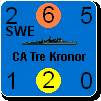Shannon V. OKeets
Posts: 22095
Joined: 5/19/2005
From: Honolulu, Hawaii
Status: offline

|
quote:
ORIGINAL: hakon
Hi.
I've also toyed with the concept of a common "surrender area". But, after thinking about it, I don't think it provides a satisfactory protection vs gaminess.
Consider, for instance: Japan sets up a somewhat strong force to the west of Harbin in M/A 40. Russia responds by building many land units in the cities they have in the area (which mostly means to the east of Manchuria). Japan attacks in M/J, and manages to reach the railroad junction to the east of Chita, as well as maintain control of a strip of hexes all the way down to China.
Meanwhile, Russia is winning the war in the east of Manchuria, particularily in the South. They take Harbin and Kirin, and gradually push their way down to Port Arthur. Russia in not able to cross the Nen River in M/J. In J/A Russia builds additional reinforcements in the far east, and are now far stronger than the Japanese in the area. During that turn, they both capture Port Arthur, and also penetrates the Nen river. But during the turn Japan manages to take a few extra hexes to the north of the railroad at Chita, making it almost impossible for Russian units to walk around the Japanese controlled territory. (10 or so mountain hexes).
Realizing that the Russians are too strong, the Japanese surrenders at the end of J/A 40.
Now, what should be done about the hexes that Japan controls around Chita? If Japan gets to keep these hexes, the Russian army for sure will not be able to relocate to Europe before a M/J 1941 (which will be catastrophic if there is a Barbarossa).
Personally, I think it would be best, safest and easiest if only the winner of the war (the one NOT surrendering) gets to keep the hexes that he controls, on top of the regular surrender areas, while the loser always should be forced to give up any territory gained after the war was declared. If both sides agree, they can of course make another treaty, but in order to be able to enforce a peace treaty, the surrendering party should be forced to give up any territory considered essential by the victor.
If this is too difficult to code, then at least make sure that Japan has to give up any controlled Mongolian or Russian home country hex when surrendering, while making sure that Russia have to give up any controlled Manchurian or Chinese hex when surrendering, as well as probably any hex in south east asia. (A crazy russian player could DOW Japan in 1942 or so, and quickly invade the philipines, Hong Kong, NEI, etc, and then surrender. (Especially if anticipating an upcoming Japanese attack).
As for the partitioning line for territory that Russia has to give to Japan when surrendering, I believe the line should be drawn directly north-south, from map edge to map edge. This means of course that Russia would keep no Pacific coastline after surrendering. In particular, I don't think Russia should be able to keep any ports on the Pacific map after surrendering. In fact, I believe that preventing a future Russian pacific fleet would be a primary objective for the Japanese high command when considering any such peace treaty.
Cheers
Hakon
If you read the text to the right of the screen shot, you'll see that the idea is the side which surrenders gives back any hexes they have taken from the other major power.
As surrender is defined above, the only ports that the USSR would retain in the Pacific would be minor ones and they would all be out of supply.
_____________________________
Steve
Perfection is an elusive goal.
|
 Printable Version
Printable Version




















 New Messages
New Messages No New Messages
No New Messages Hot Topic w/ New Messages
Hot Topic w/ New Messages Hot Topic w/o New Messages
Hot Topic w/o New Messages Locked w/ New Messages
Locked w/ New Messages Locked w/o New Messages
Locked w/o New Messages Post New Thread
Post New Thread